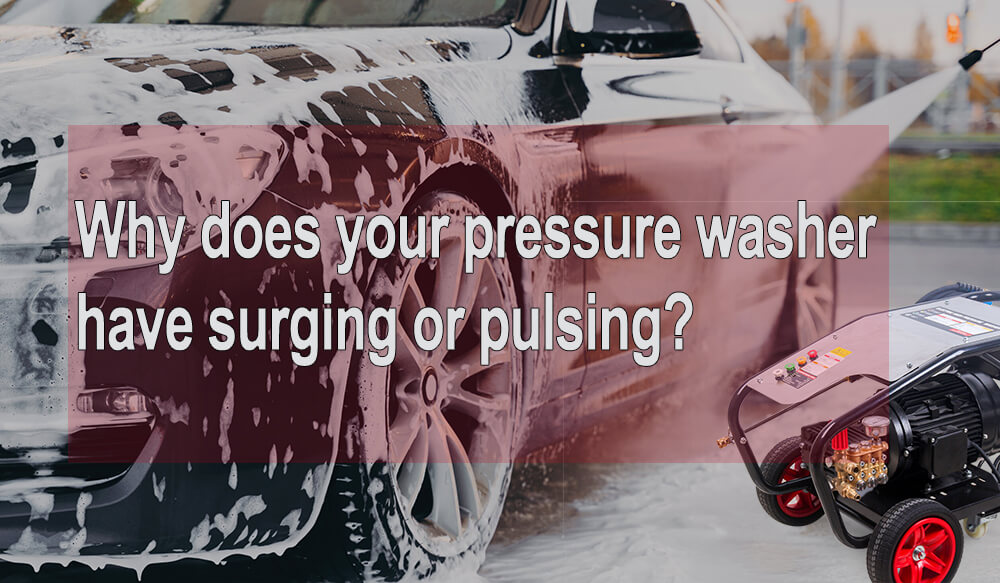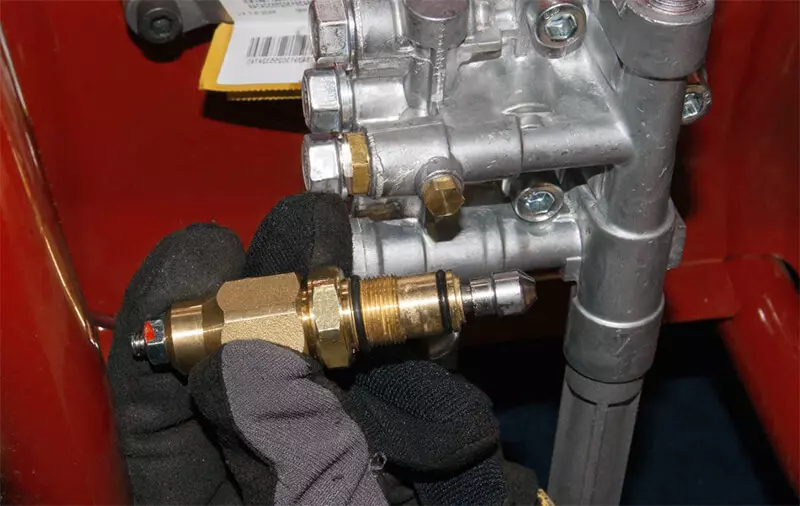12Sep 2024
table of contents

Pressure washers are indispensable for home and business cleaning jobs, they can swiftly handle tough dirt, grime and stains, making for efficient cleaning of driveways, cars, decks and such. Nevertheless, users often face issues like surging or pulsing, where water pressure isn't consistent. This is irritating and may also hurt the performance and lifes of high pressure washer.
In this blog, we'll explore typical reasons behind the surging or pulsing of pressure washer. Additionally, you'll get troubleshoot these issues and preventive tactics to aid in re-establishing a steady, unvarying pressure in your cleaning equipment.
Surging or pulsing in pressure washers indicates inconsistent and fluctuating water pressure during use. Rather than maintaining an even stream, the water pressure toggles between intense and soft levels, resulting in what is termed as 'surging' or 'pulsing' in the pressure washer.
surging or pulsing can impact the efficiency and durability of pressure washer. Inconsistent water pressure can diminish efficiency of cleaning, complicating removal of tough dirt and filth. Furthermore, such an irregular performance can put excessive burden on the components of pressure washer, then accelerate the occurrence of deterioration and damage. Over time, continued surging can lead to more severe damage, cause part failures, and increase the likelihood of costly repairs or the need to replace equipment altogether.
Identifying the signs of surging or pulsing early can help you fix the problem before it leads to more serious issues:
The water pressure output fluctuates noticeably, with pressure alternating between high and low.
It becomes difficult to get consistent cleaning results, especially on tougher stains or dirt.
The pressure washer makes unusual noises, such as sputtering or irregular sounds.
The pressure washer vibrates or shakes excessively during use.
The hose may visibly pulsate or shake as pressure surging.
Knowing these definitions, effects and signs is key to diagnosing and resolving surging or pulsing problems in your pressure washer. Next, we'll explore specific reasons behind these issues.
Understanding potential causes of surging or pulsing in your pressure washer is essential to diagnosing and resolving the problem. Here are common causes:
One of the most common causes of surging or pulsing stems from water supply problems. Pay attention to following issues:
Insufficient water flow: When water flow isn't quite adequate, could lead to air getting trapped in the system of pressure washer, resulting in pressure surging.
Blocked or wound-up hose: hose is partly clogged or knotted, it can slow down water flow.
Air bubbles in the water line: These can disrupt steady water flow, causing surging or pulsing in pressure.
The pump is central to a pressure washer's operation, affects its efficiency:
Pump seal wear: Over time, pump seals can wear out or suffer damage. This problem can lead to leaks and sudden changes in pressure.
Worn pump valves: Much like these seals, pump valves can also deteriorate. This can disrupt the pump's capability to hold consistent pressure.
Faulty unloader valves: These valves regulate the pressure in the system. A faulty unloader valve can cause surging because it cannot maintain a steady pressure output.
Nozzle's size and cleanliness are vital for stable function.
Incorrect size: nozzle is too large or too small, will affect pressure balance.
Nozzle blockages: Obstructions in the nozzle from debris can disrupt water flow, leading to pulsing.
Besides issues with the water supply, pump and nozzle, other factors can also lead to erratic water flow:
Electrical problems: Defective components, like a faulty motor or power switch, may make an electric pressure washer run unevenly.
Fuel problems: In gasoline pressure washers, issues like bad fuel, blocked fuel lines, or carburetor trouble can impact performance.
Clogged inlet filter: A blocked filter can limit water intake, causing surging flow.
Addressing these common problems is the first step toward detailed troubleshooting and repair, enabling effective diagnostics and solutions.
Below are comprehensive troubleshooting steps and fixes for each common problem.
Ensure adequate water flow: Verify your water source is providing adequate water flow by making sure the faucet is fully open.
Clear kinks and blockages: Inspect hoses for any bends or obstructions. Make sure hose is unobstructed and not squeezed anywhere. If needed, clean or swap out the hose to maintain free water flow.
Bleed air from water supply: For electric models, unplug the pressure washer. For petrol models, shut off the engine. Connect a garden hose to pressure washer's water inlet. Turn on water valve to enable water flow through hose and into machine. Let it run briefly to expel any air trapped inside. Once the air is completely expelled, reconnect the power supply or restart the engine.
Replace pump seals and valves: Pump seals and valves may wear or get damaged over time. Check your pressure washer manual to locate these parts. Purchase replacement seals and valves that are compatible with your model and follow manufacturer's installation instructions. This task may involve disassembling a portion of washer pump, so make sure you are familiar with this level of maintenance or seek professional help.
Adjust or replace unloader valve: The unloader valve is essential for steady pressure. A faulty unloader valve impairs performance. Also, look pressure washer manual to locate and adjust unloader valve. If adjustment doesn't solve problem, replace with a new valve that fits your specific model.

Choose correct nozzle size: Using wrong nozzle size can cause pressure surging or pulsing. Check manufacturer's guide to choose the right nozzle size for your pressure washer. Switch to appropriate nozzle to ensure balanced pressure output.
Clean or replace nozzle: A blocked nozzle can disrupt water flow. Take off nozzle and use a brush or needle to clear debris. If nozzle is damaged or extremely clogged, consider replacing it. Check and clean nozzle regularly to prevent future problems.
Check and fix electrical or fuel supply problems:
For electric pressure washers: Check power cord, plug, and any electrical connections for damage. Ensure the outlet is supplying stable power. Replace any defective electrical components as needed.
For Gasoline Pressure Washers: Check fuel supply to make sure you are using fresh, clean fuel. Check and clean fuel lines to ensure carburetor is operates properly. Perform regular engine maintenance as recommended by manufacturer.
Clean inlet filter:
The inlet filter helps keep debris out of system. Locate filter, usually where water line connects to pressure washer, and inspect it for dirt or blockage. Remove filter and rinse it thoroughly to clear any obstructions. Replace filter if it is damaged or too dirty to clean effectively.
By following these troubleshooting steps and implementing the appropriate fixes, you can resolve surging or pulsing problem with your pressure washer. Ensuring that all components are functioning properly will restore consistent performance and extend the life of equipment.
Before use:
Inspect the equipment: hoses and connections for damage or leaks, and make sure they are securely connected.
Ensure adequate water supply: water source meets the flow requirements of pressure washer and water supply hose is not clogged.
Check water inlet filter: if it is obstructed, clean or replace filter to keep optimal water flow.
Choose right nozzle: Use a nozzle that matches specifications of pressure washer to avoid operational problems.
Start the machine: With the power off, run water through the system to remove trapped air.
After use:
Flush the system: Rinse pressure washer with clean water to remove any detergent or dirt.
Release the pressure: Turn off water supply and trigger spray gun to release the pressure.
Store properly: Store pressure washer in a dry place, protected from freezing temperatures, and carefully coil the hose.
Regular maintenance: Follow manufacturer's maintenance schedule and check seals, valves, and unloading valves.
Check fuel and oil levels: For gasoline models, maintain proper fuel and oil levels and perform regular engine maintenance.
Understanding the causes and solutions for pressure washer surging or pulsing is essential to maintaining the efficiency and life of equipment. But choosing a high quality pressure washer is also an important reason to consider using BISON pressure washer. It is carefully designed to minimize surging or pulsing, ensuring a reliable and efficient cleaning experience every time.
inquiry form here
BISON BLOG, All the latest news and views from Bison Machinery.
Related Articles
why does your pressure washer have surging or pulsing when to repair or replace pressure washer pumpRelated Products